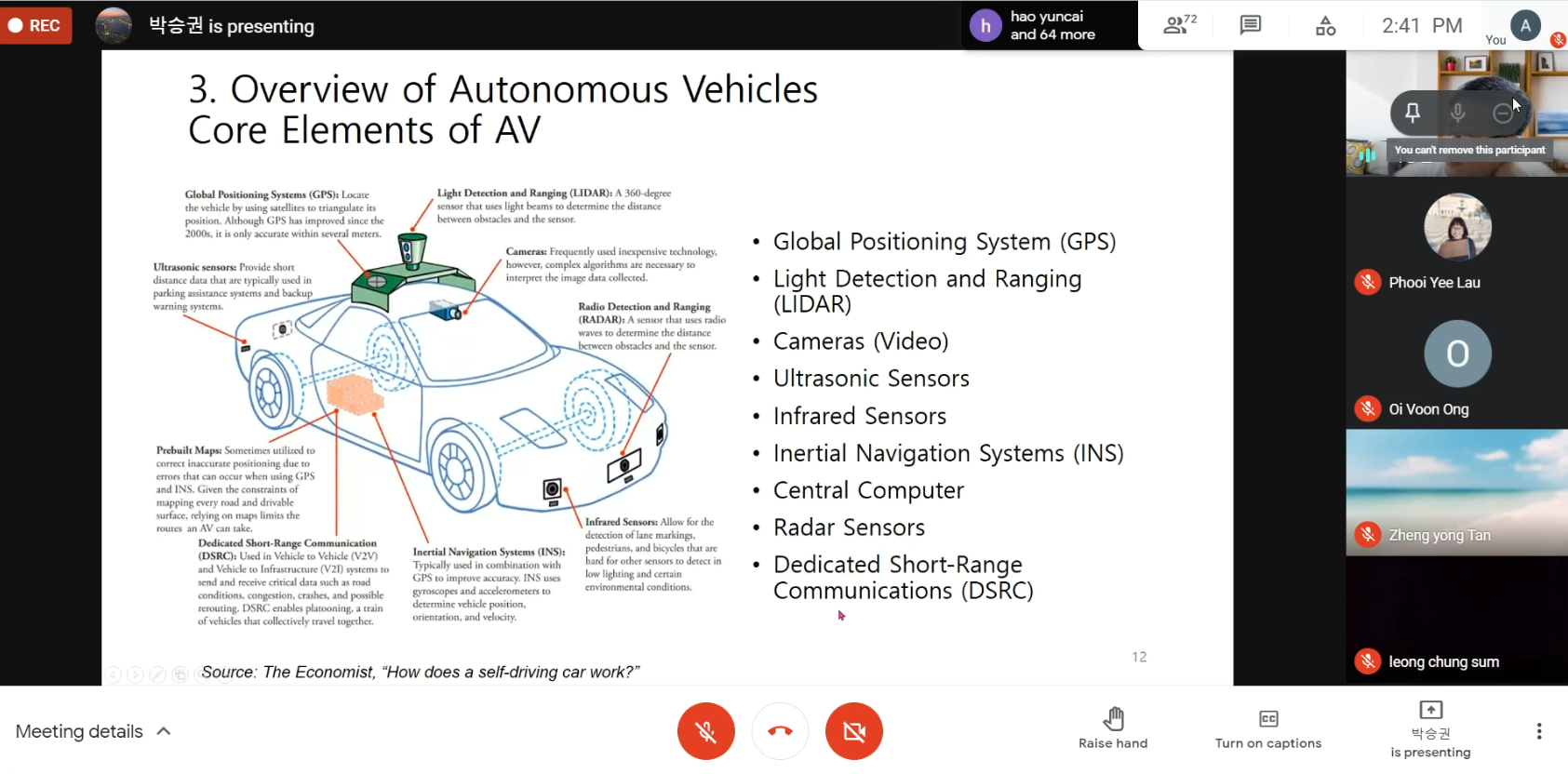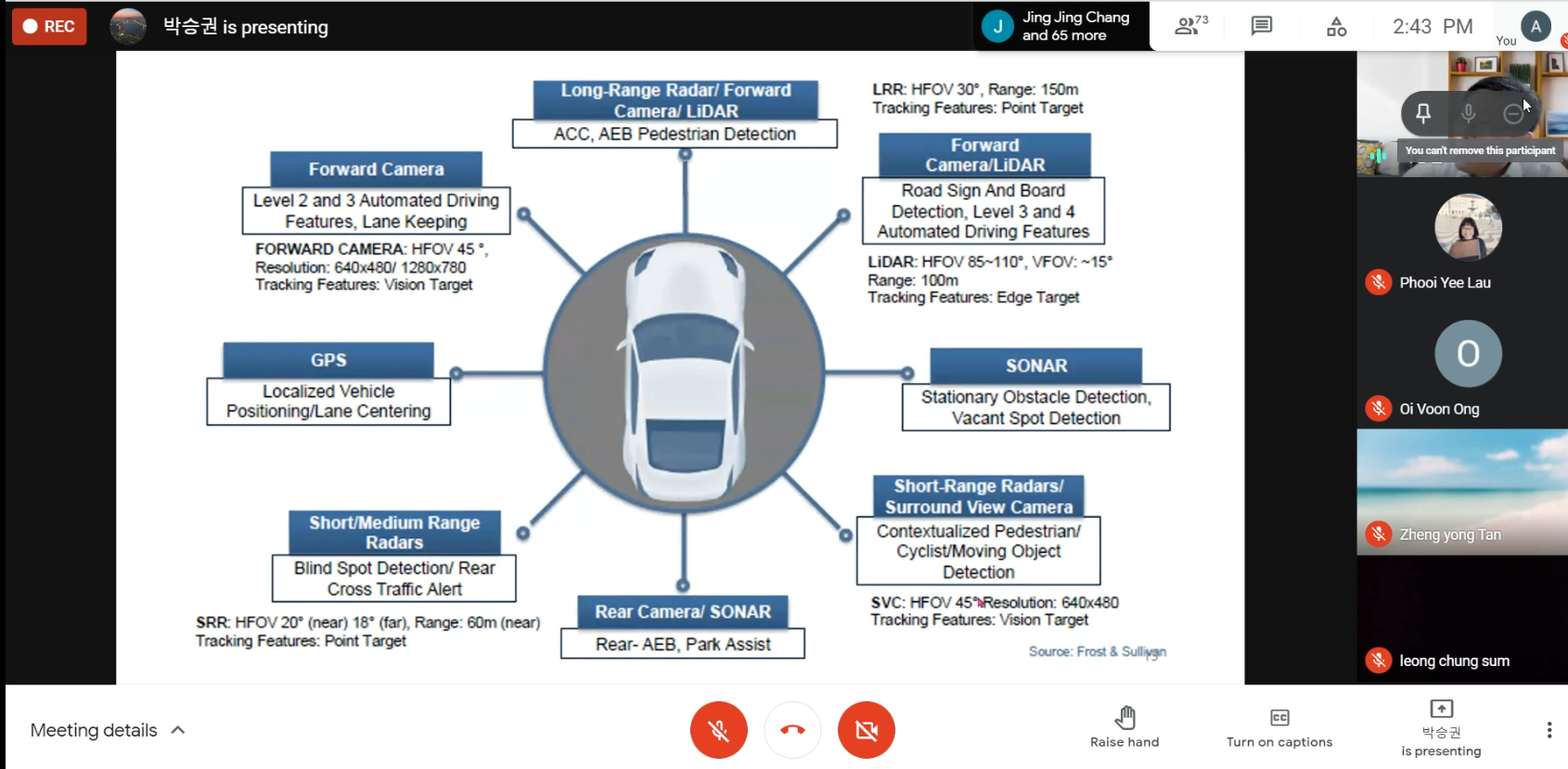
UTAR organised a webinar titled
"Autonomous Vehicle and ICT" on 21 May 2021 via Google Meet. Invited to
share at the webinar was UTAR International Collaborative Partner (ICP) Prof
Dr Park Sung Kwon, who is the dean of the College of Engineering at Hanyang
University. Moderating the webinar was Assoc Prof Ts Dr Lau Phooi Yee, a
lecturer from the Faculty of Information and Communication Technology
(FICT).
Prof Park’s webinar focused on several main topics, namely Introduction of
Autonomous Vehicles, Vehicle of the Future, Overview of Autonomous Vehicle,
Vehicle Communication, and A New Culture after Autonomous Vehicle.

Prof Park introducing the concept of Autonomous Vehicles
Prof Park started his webinar by introducing the concept of Autonomous
Vehicles, “Autonomous Vehicles have been dreamt by almost all human beings
since vehicles were invented 200 years ago. Autonomous Vehicles require so
much advancement in sensors, localisation, and information technologies
including artificial intelligence. There has been so much advancement and
development in autonomous vehicles and industry worldwide.”
He added, “Autonomous Vehicles will generate a $7trillion annual revenue
stream by the year 2050. Widespread adoption of Autonomous Vehicles could
lead to a 90% reduction in vehicle crashes. Besides, the electric vehicle
sales will surpass internal combustion vehicle in the year 2036.”
Prof Park then moved on to share the different types of future vehicles.
There are four types of future vehicles, namely Hybrid Electric Vehicles,
Electric Vehicles (EV), Hydrogen Vehicles (HV) and Autonomous Vehicles (AV).
After showing the four types of future vehicles, he explained, “Hybrid
Electric Vehicles improve the combined fuel efficiency by more than 50%. EV
do not have an internal combustion engine and transmission, this makes the
mechanical parts very simple. Although EV seem to contribute to the
environment, it is potentially controversial. HV should be called a hydrogen
fuel cell vehicle; it does not burn hydrogen but run with electricity
through an electrochemical reaction between hydrogen and oxygen in the air.
The exhaust will thus be pure water, and there are no harmful gas emission
and no batteries, so it is the most suitable vehicle for an eco-friendly
environment. The core technology of AV, on the other hand, is to go to the
destination by itself without the driver’s intervention.”

Prof Park showing the projection of electric cars 20 years from now

The five levels of automation by the Society of Automotive Engineers


The core elements of Autonomous Vehicles
Prof Park then spoke about vehicle communications, “There is a network that
connects various Electronic Control Units (ECUs) inside the vehicle. There
are more than 100 ECUs in recent luxury vehicles and it is expected to
increase to hundreds per vehicle. Until recently, the most commonly used
In-vehicle Network (IVN) in the world is Controlled Area Network (CAN), but
the bandwidth is at the level of 1Mbps.”

Prof Park explaining the types of vehicle connectivity encompassing
Vehicle-to-Everything (V2X) communications
Nearing the end of the webinar, Prof Park discussed about a new culture
after autonomous vehicle, he enthused, “When autonomous vehicles are
introduced, car-sharing service will become the new culture, since most of
the private cars are currently standing in the parking lot and the car
ownership culture is expected to change significantly with car-sharing
services. The demand for taxis, buses, truck drivers and proxy drivers will
be greatly reduced; only apps and service vehicles that call unmanned taxi
services will remain. Besides, real estate prices are also expected to
adjust significantly. It is predicted that the need for underground parking
lots of apartment and building will be greatly reduced.”
He concluded, “The spread of electric or hydrogen vehicles will be faster in
Europe than in the United States as this is due to the European
environmental regulation. AVs are expected to be quite common within five to
ten years with advances in Artificial intelligence (AI), sensor technology
and positioning technologies and it is known that Apple and Sony
self-driving cars are also under development. In AVs, the importance of
software is being emphasised and the interior of the self-driving car is
expected to reborn as a space for rest, media consumption and business.”
The webinar then saw an active interaction between the speaker and the
participants. The talk ended with an extensive yet insightful Q&A session.
![]()
Wholly owned by UTAR Education Foundation (200201010564(578227-M)) LEGAL STATEMENT TERM OF USAGE PRIVACY NOTICE